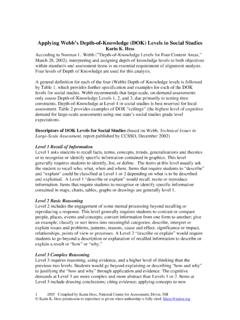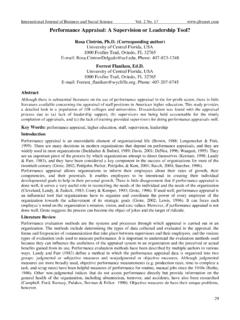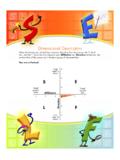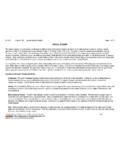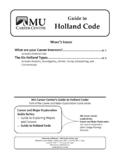Transcription of GCSE ENGLISH LITERATURE - filestore.aqa.org.uk
1 GCSE ENGLISH LITERATURE Paper 1 Shakespeare and the 19th-century novel Mark scheme MARK SCHEME GCSE ENGLISH LITERATURE - PAPER 1 8702/1 SPECIMEN 2 Mark schemes are prepared by the Lead Assessment Writer and considered, together with the relevant questions, by a panel of subject teachers. This mark scheme includes any amendments made at the standardisation events which all associates participate in and is the scheme which was used by them in this examination. The standardisation process ensures that the mark scheme covers the students responses to questions and that every associate understands and applies it in the same correct way. As preparation for standardisation each associate analyses a number of students scripts.
2 Alternative answers not already covered by the mark scheme are discussed and legislated for. If, after the standardisation process, associates encounter unusual answers which have not been raised they are required to refer these to the Lead Assessment Writer. It must be stressed that a mark scheme is a working document, in many cases further developed and expanded on the basis of students reactions to a particular paper. Assumptions about future mark schemes on the basis of one year s document should be avoided; whilst the guiding principles of assessment remain constant, details will change, depending on the content of a particular examination paper. Further copies of this mark scheme are available from MARK SCHEME GCSE ENGLISH LITERATURE - PAPER 1 8702/1 SPECIMEN 3 Statement of importance GCSE ENGLISH LITERATURE is the study of how writers communicate their ideas about the world, and how readers might respond to these ideas.
3 It aims to develop a critical understanding of the ways in which literary texts are a reflection of, and exploration of, the human condition, the study of which develops empathic understanding of human nature. High-quality ENGLISH LITERATURE is writing which displays recognisable literary qualities and, although shaped by particular contexts, transcends them and speaks about the universality of the human condition. GCSE ENGLISH LITERATURE aims to enable students to appreciate these qualities, developing and presenting informed, critical responses to the ideas in literary texts and the ways writers present these ideas. It aims to enable students to make links between a variety of written texts and between the text and the context within which it was shaped.
4 Principles of mark scheme construction Each mark scheme is driven by the task and by the statement of importance about GCSE ENGLISH LITERATURE . It aims to do two things: to describe typical features of response in order to decide on a mark to identify typical features of proficiency in order to aid discrimination between levels of performance. Each long form answer mark scheme is constructed using six levels. This is to reflect the ability level of the whole cohort. There are five marks within each level to allow for levels of proficiency and to allow for discrimination between levels of cognitive ability across the whole cohort. Each mark scheme places assessment objectives AO1 and AO2 as the key skills.
5 This is driven by the statement of importance of the subject, in that the study of great literary texts is the study of the interrelationship between the reader and the writer of the text and that the communication and reception of these ideas is an inherent feature of ENGLISH LITERATURE . It is also driven by the acknowledgement that GCSE ENGLISH LITERATURE assesses cognitive levels of ability; the level of response to ideas will have parity with the level of response to the methods of communicating those ideas. MARK SCHEME GCSE ENGLISH LITERATURE - PAPER 1 8702/1 SPECIMEN 4 How to apply the mark scheme The mark scheme is constructed using six levels of attainment that span the whole range of ability at GCSE.
6 The descriptors of attainment reference the assessment objectives for that particular question. Examiners are required to use the mark scheme to consider the whole response and decide upon the most appropriate level. The mark scheme provides two descriptors: a description of typical features of a response in each level, and a description of the kinds of skills candidates in that level will be proficient in. This is in order to support examiners in making their judgement of the extent to which the qualities and skills being demonstrated merit a particular level of attainment. As each response being marked is a response to a particular task, examiners are assessing the extent to which the candidate has responded to the task, and also the level of skill that the candidate has demonstrated.
7 Each level has five marks available and five skills descriptors. Fair application of the mark scheme to all candidates is driven by the descriptors in the mark scheme, and therefore examiners are required to make a judgement about the extent to which a candidate achieves every descriptor in that particular level in order to warrant a mark at the top of that level. If a candidate achieves everything in a level, they should be awarded the mark at the top of that level. Since answers will rarely match a descriptor in all respects, examiners must allow good performance in some aspects to compensate for shortcomings in other respects. Consequently, the level is determined by the best fit rather than requiring every element of the descriptor to be matched.
8 Examiners should aim to use the full range of levels and marks, taking into account the standard that can reasonably be expected of candidates after one or two years of study on the GCSE course and in the time available in the examination. If a candidate does not address a particular defining feature of a task, examiners are required to make a judgement about the extent to which other skills can place the response in a particular level, and where the response should be placed. Step 1 Determine a level Start at the lowest level of the mark scheme and use it as a ladder to see whether the answer meets the descriptor for that level. The descriptor for the level indicates the different qualities that might be seen in the student s answer for that level.
9 If it meets all the descriptors in the lowest level then go to the next one and decide if it meets this level, and so on, until you have a match between the level descriptor and the answer. With practice and familiarity you will find that for better answers you will be able to quickly skip through the lower levels of the mark scheme. When assigning a level you should look at the overall quality of the answer and not look to pick holes in small and specific parts of the answer where the student has not performed quite as well as the rest. If the answer covers different aspects of different levels of the mark scheme you should use a best fit approach for defining the level and then use the variability of the response to help decide the mark within the level; if the response is predominantly level 3 with a small amount of level 4 material it would be placed in level 3 but be awarded a mark near the top of the level because of the level 4 content.
10 MARK SCHEME GCSE ENGLISH LITERATURE - PAPER 1 8702/1 SPECIMEN 5 Step 2 Determine a mark Once you have assigned a level you need to decide on the mark. The descriptors on how to allocate marks can help with this. The exemplar materials used during standardisation will help. There will be an answer in the standardising materials which will correspond with each level of the mark scheme. This answer will have been awarded a mark by the Lead Examiner. You can compare the student s answer with the example to determine if it is of the same standard, better or worse than the example. You can then use this to allocate a mark for the answer based on the Lead Examiner s mark on the example.










